Top News
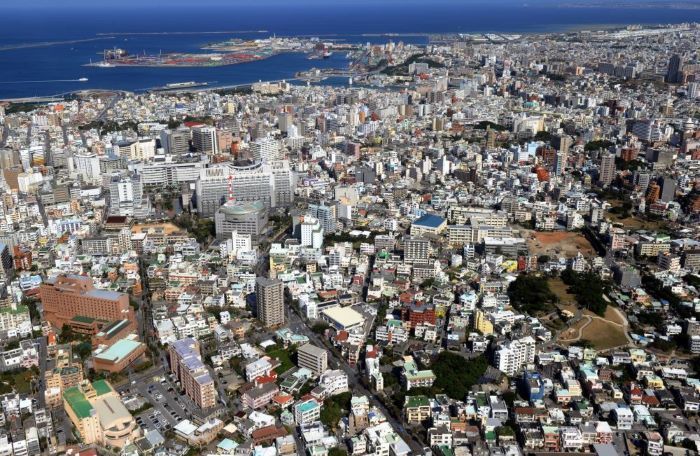
March 11, 2022 Ryukyu Shimpo
By Chikako Maemori
March 11 marks the 11th anniversary of the Great East Japan Earthquake and the subsequent Fukushima Daiichi Nuclear Power Plant accident that devastated Japan’s Tohoku Region. Approximately 38,000 diasporas (as of February 8) are scattered nationwide because of the catastrophic events, according to Japan’s Reconstruction Agency. In Okinawa Prefecture, 187 evacuees currently live across 22 municipalities; The agency asserts that Fukushima Prefecture produced the highest number of displacements in the wake of the disaster, albeit no further details are provided.
The Reconstruction Agency estimates rely on data from the National Evacuee Information System, a tool that was devised after the earthquake by the Ministry of Internal Affairs and Communications. The number of internally displaced persons that evacuated to Okinawa Prefecture peaked at 1,062 in February 2013.
Critics point out that the National Evacuee Information System does not accurately capture the realities of the evacuees, since the system relies on self-reporting. Whether a person moves, returns home, or decides to permanently settle where they initially took refuge, the events are not recorded in the system unless the individual notifies the appropriate authorities.
(English translation by T&CT and Monica Shingaki)
Go to Japanese
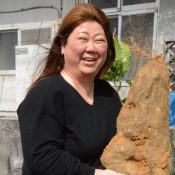
March 8, 2022 Ryukyu Shimpo
By Wakana Arakaki
Most people who grow yamaimo (Japanese mountain yam) are men, and the Yamaimo Competition (Yamaimo Subu), a contest in which farmers compete using the weight of their yamaimo, has long been considered a competition between men. However, a woman has emerged as the champion of the yamaimo competition in Maehara in Ishikawa. Harumi Yamashiro claimed victory in the white yamaimo division, breaking the previous record with her yamaimo weighing 170 kilograms. She says, “There are a lot of challenges, but I would love to see more women involved.”
Yamaimo do poorly in dry conditions, and so require frequent watering as well as regular fertilizing. Snails need to be kept off of them. Protection from typhoons in the summer is also essential. Yamashiro says, “You have to be very physically strong, so I understand why women might not want to try it.” Yamashiro has been helping in the fields with physically demanding tasks such as harvesting sugarcane since she was young, and doesn’t mind the work.
The Ishikawa region in Uruma is the birthplace of the yamaimo competition. Competitors are mostly men, but Yamashiro says, “I grow yamaimo, so of course I wanted to get first place and did my best.” She says that the size of a yamaimo is proportional to the love that goes into raising it. Yamashiro adds, “Gender has nothing to do with it – if we put in the effort, women can also grow large yamaimo. I hope that a lot of women will give it a try.”
(English translation by T&CT and Ellen Huntley)
Go to Japanese
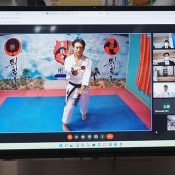
March 7, 2022 Ryukyu Shimpo
By Sayaka Yoshida
In order to further the study of peace by passing down Okinawan traditional karate, and to strengthen relationships with people of Japanese descent in other countries, JICA Okinawa hosted an online seminar for Japanese descendants abroad titled, “spreading Okinawan traditional karate to help list it on the UNESCO intangible cultural heritage list. The lessons were attended by eight people from Peru and Brazil, and took place over the course of a month from February 4-28. They studied the forms, technique, and spirit of Okinawan traditional karate, and through this passing of knowledge they were also able to exchange points of view.
The participants each watched instructional videos that taught the history, etiquette, breathing techniques and stances of Goju-ryu karate. Then, International Okinawan Goju-Ryu Karate-do Federation instructors Masakazu Kuramoto and Yoshinori Yonesato guided them on their forms and technique over video online. Each day, there were Spanish and Portuguese interpreters present to help interpret the instruction.
On the final day, February 28, the students presented the Okinawan traditional karate katas and lessons they had learned during the seminar.

International Okinawan Goju-Ryu Karate-do Federation instructors Masakazu Kuramoto and Yoshinori Yonesato providing instruction over video – February 28, Higaonna Karate Dojo in Naha
Jose Mario Tavares Monteiro, who participated from Brazil, said, “The establishment of the Okinawa Karate Hall put Okinawan Karate on a global level, and I support it making the UNESCO intangible cultural heritage list.
Rosa Bertha Chaman Comotto, who joined from Peru, said, “I think it is important to teach children not just the forms and techniques of karate, but also the essence and lifestyle.”
After the kata presentations, the participants provided feedback such as “I learned something I never knew before,” and “I want to visit the Okinawa Karate Hall. I want to practice together in Okinawa.”
One of the instructors, Kuramoto, said, “I am happy with the effort everyone put into the lessons. I want you to remember the pieces of the katas, and keep the spirit of “one more time” to keep practicing. I hope that you spread traditional karate to lots of people in each of your countries, so that it is continued to be passed down.”
(English translation by T&CT and Sam Grieb)
Go to Japanese

March 4, 2022 Ryukyu Shimpo
By Yosuke Anri
Tokyo – Japan’s cabinet office announced March 3 that they would be proceeding with the introduction of crime prevention duties for taxis in Okinawa as part of the “Okinawa Regional Safety Patrol Corps” (often referred to as the Blue Patrol) program, which began as part of the policies aimed at preventing incidents involving members of the U.S. military after a woman was raped and murdered in 2016. Since the implementation of the system in June of 2016, there have been no more than 10 reported incidents involving people associated with the U.S. military bases.
This was in response to Kunio Arakaki (Social Democratic Party) in the House of Representatives special committee on Okinawa and Northern Territories affairs.
According to the cabinet office, the duties that will be given to the fleet of taxis will consist of steps to report any incidents they encounter to law enforcement using a computer system that will be installed in Okinawan taxis. A pilot project for this has been underway since 2018, and the plan is to roll this out to the 3,600 taxis in operation in Okinawa over the course of 2022.
Hiroaki Hara, the minister in charge of implementing the policy, commented, “in the six years since establishing the policy, we have accumulated a measure of expertise. We are planning on a more efficient running of the operation for the future.”
Arakaki said that, “there were some voicing concerns about cost-effectiveness,” and asked for a report on the number of incidents related to the U.S. military. Arakaki indicated that there was a cumulative total of 1,844 reported incidents, and that only 10 of these were related to the U.S. military.
(English translation by T&CT and Sam Grieb)
Go to Japanese

March 4, 2022 Ryukyu Shimpo
By Miho Iwakiri
Due to an inspection of the tap water conducted in Kin Town in February, it came to light on March 3 that a level of 59 nanograms per liter (ng/L) of harmful organic fluorine compounds known as PFAS, a level exceeding the national provisional guideline value, was detected in the tap water. A level of 70 ng/L of PFAS, also exceeding the guideline value, was detected in tap water from the same water purification plant in June 2020. This most recent inspection is the second inspection of tap water from this water purification plant. Given that the U.S. military’s Camp Hansen may be the source of the pollution, the Okinawa prefectural government and Kin Town government are requesting, through the Japanese government, that the U.S. military allow entrance to Camp Hansen for an investigation, but have yet to conduct the investigation.
>>What are PFAS? Previously used for frying pans and the like…
The Japanese government has stipulated “a total of 50 nanograms of PFOS/PFOAs per 1 liter” as the aforementioned provisional guideline value.
Kin Town supplies tap water that is a mixture of purified groundwater and water from the Prefectural Enterprise Bureau, 70-80 percent of which is water from the Prefectural Enterprise Bureau. According to a spokesperson from the Kin Town government, a level of 59 ng/L was detected in tap water from one site in Kin Ward out of three sites from which tap water was sampled on February 21. A level of 180 ng/L was recorded at two out of six sites that serve as water sources in Kin Ward.
Before this point, due to PFOS/PFOAs having been detected at levels exceeding the provisional guideline value, the Kin Town government had already stopped drawing water from five sites that normally serve as groundwater sources.
Having received this round of inspection results, the Kin Town government has, as of March 2, stopped using one of the two sites that serve as groundwater sources and where a level of 180 ng/L was detected. Currently, the water quality at six sites that serve as water sources is being reinspected. The Kin Town government is considering whether it is possible to resume drawing water from sites where the numerical value has dropped below the provisional guideline value in the inspection results confirmed on March 4.
Kin Town is moving to quickly service the water main so as to switch to using entirely water from the Prefectural Enterprise Bureau in fiscal year 2023. Town Mayor Hajime Nakama said, “My apologies for causing the townspeople to worry once again. I will continue making efforts to return [levels] to the guideline value, and I will continually ask the national government for an investigation on the base and for health evaluations for the townspeople.”
(English translation by T&CT and Erin Jones)
Go to Japanese

March 3, 2022 Ryukyu Shimpo
By Yosuke Anri
Tokyo and Okinawa Prefecture are co-hosting the 50th-anniversary ceremony of the Reversion of Okinawa to Japan. During an interview conducted before March 2, an official revealed some details of the May 15 celebration, including the key attendees—Prime Minister Fumio Kishida, heads of the judicial, legislative, and administrative branches of government, former Ministers of State for Okinawa, and the U.S. ambassador to Japan. The Tokyo government set up a planning committee for the ceremony and appointed Chief Cabinet Secretary Hirokazu Matsuno to take the reins. The event will utilize two venues and arrangements are being finalized for the banquet hall of the Grand Prince Hotel New Takanawa in Minato-ku, Tokyo, and the Okinawa Convention Center in Ginowan City, Okinawa. The two venues will connect virtually.
Organizers will implement measures to prevent the spread of COVID-19, extending invites to only local elected officials and former Diet members from Okinawa to prevent high numbers of travelers from visiting the Okinawa venue. The Cabinet will officially approve the affair on August 8.
The event will be the first to be held simultaneously in both Okinawa and Tokyo since the May 15, 1972 celebration, according to the Cabinet Office. The dual-venue ceremony in 1972 was hosted by the central government, held at the Nippon Budokan in Tokyo and the Naha Civic Hall in Okinawa, with approximately 10,000 people attending in Tokyo and 1,500 in Okinawa.
The 10th- and 20th-anniversary ceremonies of the Okinawa Reversion were held in Tokyo, and the 25th-, 30th-, and 40th-anniversary ceremonies were held in Okinawa. The events in Okinawa attracted around 700 to 1,000 attendees.
This year will be the first time the anniversary ceremony in Tokyo will be held at a hotel. The Grand Prince Hotel New Takanawa has been the venue for the “Okinawa Night in Tokyo” event, an evening of celebrating Okinawan tourism, attended by about 1,000 people including the Chief Cabinet Secretary and the Minister of State for Okinawa.
(English translation by T&CT and Monica Shingaki)
Go to Japanese

March 1, 2022, Ryukyu Shimpo
By Kotaro Nagamine
Kunigami – On February 28, representatives of Kunigami and Yoron, Kagoshima reenacted the exchange of goods between the two towns that occurred regularly before World War II. The exchange was one event commemorating the 50th anniversary of Okinawa’s reversion to Japan.
At approximately 11 a.m. on February 28, a fishing boat from Yoron arrived at Ginama Fish Harbor in Kunigami carrying goats. Mayor Yasushi Chibana of Kunigami greeted the boat, and exchanged wood from the Okinawa pine for the goats. The wood was provided by the Kunigami Forestry Association. The towns plan to reenact a meeting on the water and to light torches in both towns on April 28. The wood provided by Kunigami will be used as fuel for the torches in Yoron. Katsuo Tabata is the head of the Yoron association responsible for the commemoration of the reversion. He brought the goats to Kunigami and spoke about the history between the towns, saying, “I pray that the exchange between our two towns will thrive.” Mayor Chibana said, “Let’s work together to make sure that the events planned for April 28 are a success.”
(English translation by T&CT and Ellen Huntley)
Go to Japanese

March 1, 2022 Ryukyu Shimpo
By Masatoshi Inafuku
The Asato – Daido – Matsugawa Island-wide Association gathered at Asato Crossroads in Naha, raising placards calling for peace and protesting the Russian invasion of Ukraine. The group included someone who lived through the Battle of Okinawa, who said, “What is necessary is not war, but peace and friendship.”
Akio Gima, 94, who was pressed into the Blood and Iron Student Corps in the Battle of Okinawa to dig trenches for the Japanese Imperial Army’s (JIA) 32nd field fortification corps, raised a placard with “bridge of nations” written on it, calling for an end to war to commuters on their way to work. In the Battle of Okinawa, Gima weaved his way between the Ryukon Go Cave being used by the students and the 32nd Army. When the tide of the battle started to go sour, he retreated to Nanbu along with the (JIA). He lost many friends during this time.
“It was all I could do to keep myself alive. Before the battle I thought there was no way the ‘land of the gods’ could be defeated, but I quickly came to realize that was not the case,” he reflected, and gave a sharp insight of the invasion of Ukraine, saying, “War itself is a mistake.”
The person who raised the idea of the protest was the associations sponsor, Taizan Maezato, 77. He raised his concerns of the increasing calls for additional military fortifications in Okinawa in the wake of the invasion of Ukraine and the emergency in Taiwan, commenting, “The bases themselves are a source of the increasing tensions. Now is the time to make appeals for peace and friendship.”
(English translation by T&CT and Sam Grieb)
Go to Japanese
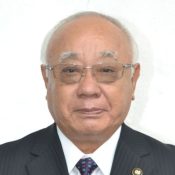
February 22, 2022 Ryukyu Shimpo
Former Miyakojima mayor Toshihiko Shimoji, 76, who was indicted for bribery in the Japanese Ground Self-Defense Force (JGSDF) land acquisition corruption scandal in Nobaru Ueno, Miyakojima, was found guilty by the Naha District Court on February 22, and sentenced to 3 years in prison, a 5-year suspended sentence, and fined 6 million yen (the recommended sentence was for 3 years and a 6 million yen fine).
The defense admitted to accepting cash, emphasizing that the acquisition of land was a sale between the government of Japan and the landowner. They claimed that they were not guilty of any crime stating, “the funds were a campaign contribution, and did not constitute a bribe.”
The crime of bribery is defined as a public official receiving compensation for executing the duties of their office, and applies when said official receives money or gifts while being aware that it is a bribe. In the trial, the main points being debated were 1. If accepting the request [to purchase land] fell within the duties of his office 2. If the money was compensation for executing said duties, and 3. If the recipient was aware that it was a bribe.
According to the indictment, when he was mayor Shimoji accepted the plan for the JGSDF garrison, and received payment for facilitating the sale of the Chiyoda Country Club to the Japanese government, receiving approximately 6 million yen in cash in Tokyo on May 24, 2018 from the Chiyoda Country Club’s then president, who was also convicted of bribery.
(English translation by T&CT and Sam Grieb)
Go to Japanese
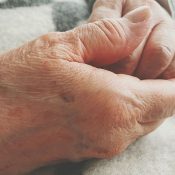
February 25, 2022 Ryukyu Shimpo
The news that Russia began its attack on Ukraine broke on February 24, instantly sending the world, including Okinawa, into a frenzy. The question on everyone’s lips is, “Will this plunge us into a time of war?” Okinawan citizens are concerned about the effect this will have on Okinawa, where U.S. military bases are concentrated. Okinawan citizens, touching on their experiences from the Battle of Okinawa, have voiced their concerns for the citizens of Ukraine, being toyed with by a large nation like Russia.
Yasuko Onaga, 92, of Naha City, who experienced the Battle of Okinawa when she was 15 years old, criticized Russia’s attack, saying, “Just the thought of starting a war, itself, is disgusting. I don’t expect to see any signs of humanity.” During the Battle of Okinawa, Onaga belonged to a Kyodo Butai (a troop from her hometown) as a nurse and as kitchen personnel, and had to try to escape during the intense bombardment of the southern part of Okinawa. She showed concern for Ukrainian citizens, saying, “I don’t want anyone to have that sort of experience. An armed person who goes to a safe place to become a pawn [of war] is, in the end, a weak person. Doesn’t it seem that politicians only consider people’s lives on par with insects?”
Hikonobu Toguchi, 95, of Yomitan Village experienced the Battle of Okinawa, having been conscripted right after graduation from the Prefectural School of Agriculture and Forestry. He said, “Military force is foolish. It is better to devote oneself to peace diplomacy.” Toguchi was a prisoner of war in the postwar period and spent time at an internment camp in Hawaii. He called for a deliberate dialogue, saying, “War is wretched, there is no victory or defeat. Both sides are wounded.”
Osamu Ogata, head of the East Asian Community Institute Ryukyu Okinawa Center, said, “Russia’s military strike was absolutely inexcusable. The citizens are the victims here. The president should stop military movements at once.” Ogata also said, “A military conflict in Ukraine could also have a negative impact on East Asia, such as the Taiwan emergency or the Senkaku Islands. I would like Europe and the United States to refrain from military intervention, and for the United Nations, for example, to attempt a peaceful resolution through international dialogues.”
Etsuko Urashima, 74, of Nago City, who has been participating in the peace movement in Okinawa for many years, said, “Military force only produces hatred. The citizens at the site [of the attack] are being toyed with by the government of a large nation and the military affairs game.” On top the construction of the Futenma Replacement Facility and the deployment of missile units in Okinawa, Urashima also expressed apprehension about the matter at hand, saying, “Resolution by means of military strength only complicates the problem. It leads to retaliatory fighting, and instability around the world. I feel this will plunge us into a time of war.”
(English translation by T&CT and Erin Jones)
Go to Japanese

February 20, 2022 Ryukyu Shimpo
By Takahiro Kina
Okinawa City – On February 6 in central Okinawa, Chubu Shashinkan (Chubu Photo Studio) had a passing of the torch ceremony, with Yutaka Tokeshi, 22, officially taking over the store from its previous owner, Yoshinobu Kuba, 79. The photo studio, which is on Palmyra Street in Koza, opened in 1971 in what was then called Hinode Street, and for half a century has been photographing things like town festivals and people’s special commemorative occasions.
The Chubu Shashinkan had also been the photographer for the Okinawa tourism goodwill ambassador “Miss Hibiscus” event since 1975, but this generation of photography has moved from film to digital photography and smartphones.
When it came to their 50th anniversary last year, usually an auspicious milestone, they had decided to close.
Then, while taking apart one of their old machines in front of the store, Tokeshi happened to be walking by and struck up a conversation, forming a new friendship.
“It would be a waste for this photo studio, which has been rooted here as Koza changed around it, to go away,” said Tokeshi, who decided to take over the studio.
Kuba, who invited friends to the passing of the torch ceremony, gave words of encouragement, saying, “I am thankful the store name will stay. I am also relieved that Tokeshi will continue on with the store. I hope he will do his best for the next 50 years.”
Tokeshi said of his aspirations, “I want to make use of both film and digital to meet the needs of our customers. I want to capture lasting memories of the customers who come to Koza.”
The reopening is scheduled for March 6. Business hours will be 11:00 a.m. to 8:00 p.m. There are no planned days off. The address is Okinawa City Chuo 1-17-18. For inquiries call (Tel.) 080 (3189) 6785.
(English translation by T&CT and Sam Grieb)
Go to Japanese












 Webcam(Kokusai Street)
Webcam(Kokusai Street)


